How to Water Succulent Plants
Succulents are not like most other plants. So naturally, if you try to water them like other plants, especially other house plants, they aren’t going to survive!
However, this doesn’t mean you can neglect them completely.
Succulents and Sunshine is reader supported. We may earn a commission, if you purchase through links on our site, such as Mountain Crest Gardens, Amazon, or Etsy. We only promote products we use and trust.
These two extremes are what make it seem like succulents are hard to grow. But with this simple watering method, you’ll be able to give you succulents enough water to thrive.
If you're ready to dive right in, you can jump to one of the following:
- How to Water Succulents
- How frequently should I water succulents?
- Why does this work?
- Using the right soil is critical
- Use a pot with a drainage hole
- How to water leaf propagation
- Watch for signs from your succulents
To help you even further, download my free cheat sheet to see what it looks like when your succulents need more or less water. Click here to grab that, it'll be super helpful.
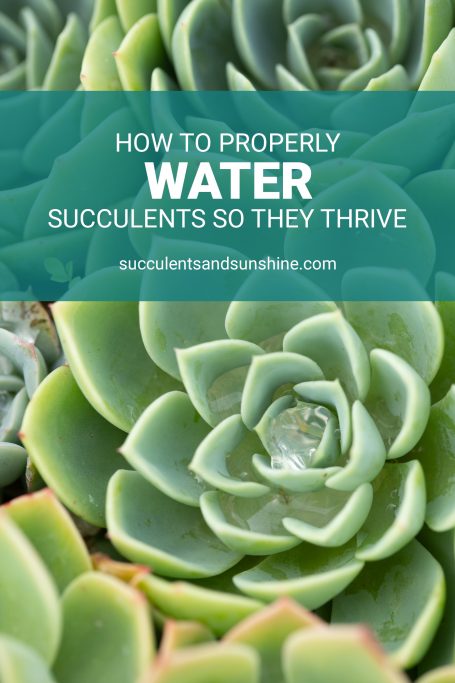
Keep a record
One of the best pieces of advice I can give you to help your succulents succeed and to help you get your watering schedule “just right” is to record when you've watered.
Knowing when you've watered last will help answer a lot of questions about whether or not it's time to water again.
There's a lot of great ways to keep track of this — pen and paper, excel spreadsheet, notes on your phone — but my favorite way is to use the Succulent Tracker app (Apple | Android). It allows you to easily record each time you water, shows your watering history for each plant, reminds you when it's time to water, and allows you to keep a photo history of the plant too.
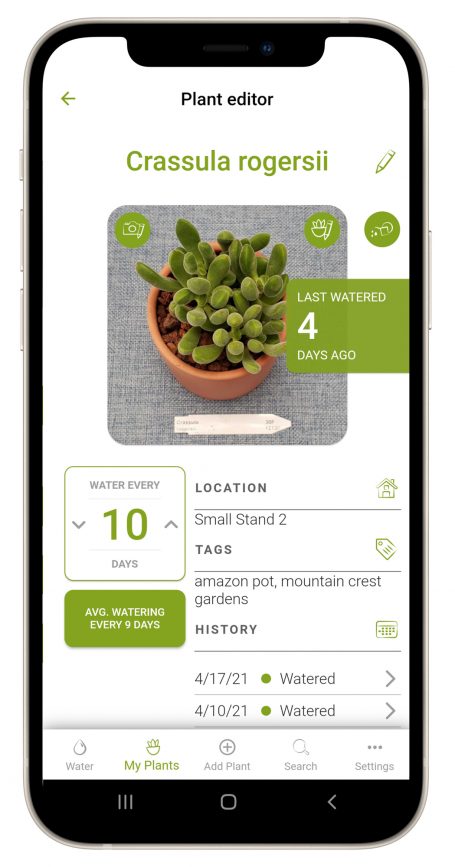
There are a lot of different ways to use the app, but keeping track of watering has been a gamechanger for my succulents!
How to Water Succulent Plants (indoors and outdoors)
The best way to water succulents is with the “soak and dry” method. Soak the soil completely then let the soil dry out completely before watering again. And make sure the succulents are in a well draining soil in a pot with a drainage hole (more on that in a minute).
Pretty simple, right? See this method in action:
For indoor succulents, it is generally best if water doesn’t get on top of the leaves. If it sits on a leaf for too long it can cause rot.
Use a small spout watering can (this one is fantastic) or a squeeze bottle (like the one in this super handy tool kit).
This isn’t as much of an issue for outdoor succulents because there is more airflow and the water will dry out quicker.
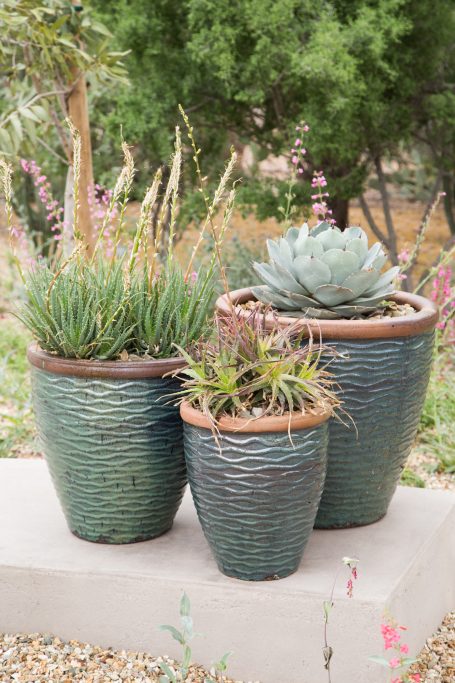
If possible, just pour water onto the soil around your succulents until it is completely soaked. DO NOT water your succulents again until the soil has dried out — from the top of the pot to the bottom.
Succulents do not like to sit in wet soil for more than 2-3 days.
So then comes the question…
How often should I water my succulents?
Succulents should be watered only when the soil has dried out completely. There is no universal watering schedule that works for every succulent in every climate.
Many indoor succulent growers find that watering 14-21 days is a good frequency to keep their succulents alive. Use this timeline as a starting point and adjust as needed.
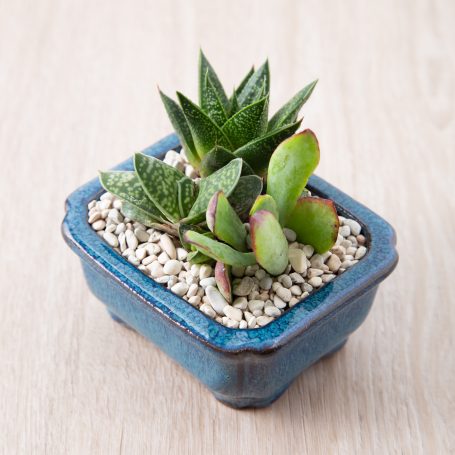
Remember to get the free cheat sheet to see what it looks like when your succulents need more or less water. Click here to grab that.
The best frequency for watering your succulents is whenever the leaves show very early signs of under watering. Grab that cheat sheet above so you know that that looks like.
Since most succulents are very prone to rot with frequent watering, you’re best off to wait for a signal from your succulent before watering.
But if nothing else, don’t water again until the soil is totally dry.
And remember, keeping track of your watering schedule is really important. I can't tell you how many times I “think” I haven't watered in a while, only to find out, thanks to my notes in the Succulent Tracker app (Apple | Android) that it was just a few days ago.
Find out a few things that may affect how often you water your succulents in this video:
Why does this watering method work?
Succulents are generally native to areas where the soil drains quickly and water is heavy, but infrequent. Think about cacti (a subcategory of succulents) out in the desert… They get flash floods of water, with storms lasting 24-28 hours, followed by weeks without any water at all.
While your succulents, especially indoors, don’t need a watering schedule this extreme, they will benefit from the “soak and dry” approach.
With a deep watering the succulent has plenty of access to water. During the “drought” between watering, the succulent will begin to grow new roots, searching for more water.
The soak and dry method helps the succulent develop a large, healthy root system which will enable it to withstand longer periods of drought than most other plants.
DO NOT use a spray bottle for watering. Constant watering with small amounts of water, like with a spray bottle, will produce a weak root system that can’t withstand very long periods of drought.
That means if you don't water for a couple days your succulent will die. Or if you don't get the water deep enough when you spray with a spray bottle, the succulent will die. So don’t do it 🙂
Soak and dry… soak and dry…
The right soil is crucial for watering success
At the very beginning of the article I mentioned your succulents should be planted in a well draining soil AND in a pot with a drainage hole.
Succulents will quickly rot if they are in wet soil for too long. Ideally, your soil will be mostly dry, especially the top half of the pot, within 2-3 days.
So what makes a soil “well draining”?
I’ve dedicated a full post just to talking about the perfect soil mix for succulents. You can read that here.
The short answer is a well draining soil looks “gritty” because it has ¼” (6mm) particles. ⅔ of the soil should be inorganic (rock) and ⅓ should be organic (pine bark, coconut coir, etc.).
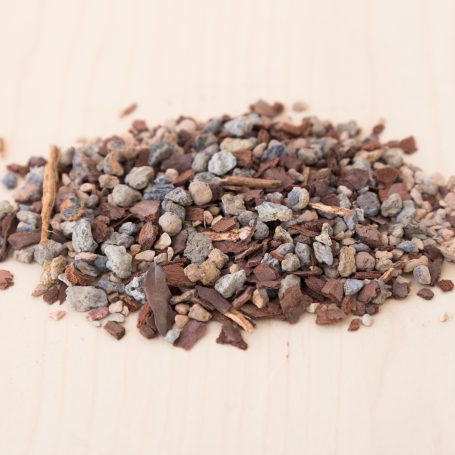
Traditional soil will not work well for succulents. It stays wet for much too long. I don’t generally recommend using most of the “Cactus and Succulent” soils found at most nurseries either. They tend to be too organic and still don’t drain fast enough.
If you’re new to succulents or have killed a few succulents from too much water, I highly recommend getting a bag of Jack’s Gritty Mix for your succulents. This is the best succulent soil I’ve used. 95% (or more) of my succulents are planted in this and they are thriving!
Beyond that, take a look at the soil post to get recommendations for other materials and how to modify other store bought soils to make them work better for succulents.
Use a pot with a drainage hole
Another important piece of this watering method is using a pot with a drainage hole.
Remember how I mentioned succulents don’t like to sit in wet soil for very long? It’s very difficult for the soil to dry out completely if your pot doesn’t have a drainage hole.
The hole in the bottom of the pot allows for excess water to flow out of the pot and away from your succulent roots. It also provides another way for air to flow through the soil and help it dry out faster.

If you’re just starting with succulents, a pot with a drainage hole is going to be extremely helpful for you.
If you want to know how to keep succulents alive in a pot without a drainage hole, click here and I’ll show you what to do.
How should I water the succulent leaves or babies I’m propagating?
This is the one time–and the only time–that it's okay to use a spray bottle for watering your succulents–when you're propagating!
However, even still… I recommend using a squeeze bottle (like the one in my favorite tool kit) to ensure the soil gets thoroughly wet.
When you're propagating succulent leaves indoors or outdoors, you can water them every day. You want to keep the soil damp (though not sopping wet) so the leaves have plenty of access to water.
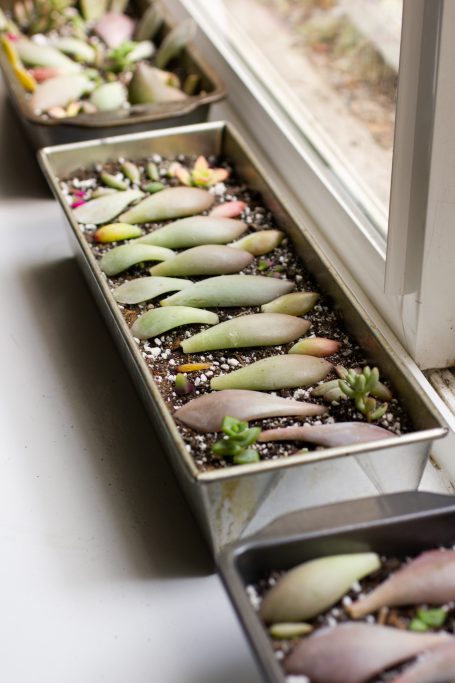
Just spray the top of the soil with a spray bottle (or use the squeeze bottle from above). Like the roots of large succulent plants, the leaves will absorb water from the air around them, so spraying the soil with a spray bottle is usually enough in my experience.
Keep an eye on your roots–they may dry out if they aren't getting enough water.
Often I can look at the soil and know I need to water.
Other times, especially when I'm starting to reduce my watering frequency for these babies, I'm not sure if it's time to water or not. Checking the Succulent Tracker app (Apple | Android) reassures me it's time to water. Plus I can record photos in the app and see the progress of my babies too!
Watch your succulents for indicators
Now that you know the soak and dry method, it’s time for you to give it a try!
Pay attention to the signs your succulent is giving you. It will start to change if it needs more water or less water. Be sure to click here to grab my cheat sheet to see what that looks like. It’ll be super helpful.
And lastly, when in doubt go without!
It is much easier to save your succulents from too little water than from too much. If you think you’ve over or under watered your succulent, click here to find out what to do next.